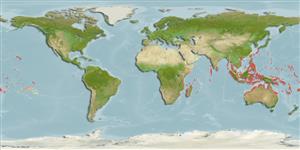>
Blenniiformes (Blennies) >
Blenniidae (Combtooth blennies) > Salariinae
Etymology: Entomacrodus: Greek, ento = inside + Greek, makros = big + Greek, odous = teeth (Ref. 45335).
More on author: Valenciennes.
Environment: milieu / climate zone / depth range / distribution range
Ecología
marino asociado a arrecife; rango de profundidad 0 - 3 m (Ref. 86942). Tropical; 30°N - 32°S
Indo-Pacific: East Africa to the Line and Ducie islands, north to the Ryukyu, Bonin, and Marcus islands (reported farther north to Wakayama Prefecture in Japan, Ref. 559), south to Lord Howe and Rapa islands.
Tamaño / Peso / Age
Maturity: Lm ? range ? - ? cm
Max length : 11.0 cm TL macho / no sexado; (Ref. 9710)
Espinas dorsales (total): 12 - 14; Radios blandos dorsales (total): 14-16; Espinas anales 2; Radios blandos anales: 15 - 18. Small dark spots on body; upper lip uniformly dusky or with scattered spots; pale area behind eye followed by an irregular dark mark (Ref. 4404).
Facultative air-breathing (Ref. 126274); Adults occur in the intertidal zone of lagoons and wave-swept seaward reefs (Ref. 9710). They inhabit holes of limestone matrix at low tide (Ref. 90102). At low tide they may be found in small pockets of water left in pitted limestone. Oviparous. Eggs are demersal and adhesive (Ref. 205), and are attached to the substrate via a filamentous, adhesive pad or pedestal (Ref. 94114). Larvae are planktonic, often found in shallow, coastal waters (Ref. 94114).
Life cycle and mating behavior
Madurez | Reproducción | Puesta | Huevos | Fecundidad | Larva
Oviparous, distinct pairing (Ref. 205).
Myers, R.F., 1991. Micronesian reef fishes. Second Ed. Coral Graphics, Barrigada, Guam. 298 p. (Ref. 1602)
IUCN Red List Status (Ref. 130435)
Threat to humans
Harmless
Human uses
Acuario: Comercial
Más información
ReferenciasAcuiculturaPerfil de acuiculturaRazasGenéticaElectrophoresesheritabilidadEnfermedadesProcesamientoNutrientsMass conversion
Herramientas
Special reports
Download XML
Fuentes de Internet
Estimates based on models
Preferred temperature (Ref.
123201): 24.9 - 29.3, mean 28.4 °C (based on 2647 cells).
Phylogenetic diversity index (Ref.
82804): PD
50 = 0.5000 [Uniqueness, from 0.5 = low to 2.0 = high].
Bayesian length-weight: a=0.00741 (0.00335 - 0.01640), b=3.02 (2.83 - 3.21), in cm total length, based on LWR estimates for this (Sub)family-body shape (Ref.
93245).
Nivel trófico (Ref.
69278): 2.0 ±0.00 se; based on food items.
Resiliencia (Ref.
120179): Alto, población duplicada en un tiempo mínimo inferior a 15 meses (Preliminary K or Fecundity.).
Fishing Vulnerability (Ref.
59153): Low vulnerability (10 of 100).
Nutrients (Ref.
124155): Calcium = 160 [76, 285] mg/100g; Iron = 0.847 [0.460, 1.523] mg/100g; Protein = 18 [17, 19] %; Omega3 = 0.0688 [, ] g/100g; Selenium = 17.5 [8.0, 41.4] μg/100g; VitaminA = 114 [27, 483] μg/100g; Zinc = 2.68 [1.71, 4.02] mg/100g (wet weight);
